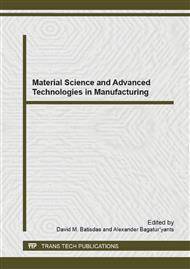p.457
p.463
p.467
p.472
p.476
p.481
p.485
p.490
p.496
Experimental Study on the Impact of Cutting Speed on Surface Integrity of Ti-10V-2Fe-3Al
Abstract:
Titanium Alloy Ti-1023 is widely utilized in aerospace industry; the integrity of the parts machining surfaces is of critical importance for aerospace industry. Surface roughness, microstructure and microhardness variations were investigated on a CNC machining at different cutting speeds. Experiments results showed machined surface integrity of Ti-1023was sensitive to cutting speed. The roughness of machined surface raised with increase of the cutting speed from 40 m/min to 100 m/min, but decreased while the cutting speed increase from 100 m/min to 300 m/min. It can also draw the conclusion that no significant phase transformation, no obvious deformation and no white layer on subsurface microstructure can be observed. As for microhardness, it can also be seen that the machined workpiece surface was not seriously hardened, less than 35μm depth of work hardening at different cutting speed.
Info:
Periodical:
Pages:
476-480
Citation:
Online since:
January 2014
Authors:
Keywords:
Price:
Сopyright:
© 2014 Trans Tech Publications Ltd. All Rights Reserved
Share:
Citation:


